Aug-24-18
 | | KEG: This game was an important turning point in the career of Schlecher. Before Munich 1900, Schlechter had demonstrated his strength, played some fine games, and made several excellent showings: (i.e., tied for 4th-5th at Budapest 1896 ahead of Tarrasch, Maroczy, and Marco; 5th place at Vienna 1898 ahead of Burn, Tchigorin, Maroczy, Blackburne, Marco, and Showalter; 5th place at London 1899 ahead of Blackburne, Tchigorin, Showalter and Steinitz; and tied for 7th-9th at Paris 1900 with Marco and Mieses and ahead of Janowski and Showalter). But Munich was Schlechter's coming out party in which he tied for first with Pillsbury and Maroczy. This was followed by: Monte Carlo 1901 (second place ahead of Tchigorin, Mieses, Blackburne, Marco, and Marshall); Monte Carlo 1902 (tied for 5th with Tarrasch and Wolf ahead of Tchigorin, Marshall, and Marco); Monte Carlo 1904 (2nd place ahead of Marshall and Marco); Coburg 1904 (tied for 1st-3rd); Ostend 1905 (4th place ahead of Marco, Burn, and Marshall); Stockholm 1906 (tied for first with Bernstein); Nurembern 106 (tied for 3rd ahead of Tchigorin, Tarasch, Vidmar, and Spielmann); Ostend 1907 (2nd, a half-point behind Tarrasch and ahead of Janowski, Marshall, Burn, and Tchigorin); Vienna 1908 (tied for 1st-3rd ahead of Rubinstein, Spielmann, and Marshall); Prague 1908 (tied for 1st ahead of Vidmar, Rubinstein, Maroczy, Marshall, and Janowski). But Munich 1900 didn't start off well for Schlechter. He drew his first two games, both of which he should have won, suggesting he was still just the "drawing master." All this turned around with this game, which began a Fischer-like sequence in which Schlechter won six games in a row and got 8.5 points in 9 rounds). Thus, this game was a major turning point in Schlechter's career. But the game was actually not one of Schlechter's best, or anything close to it. Schlechter seemed unsure how to deal with Popiel Ponziani's Opening and appeared to be in a haze for most of the game, winning only thanks to very weak play by Popiel. For whatever reason, Schlechter's career took off with this game. Let us celebrate this turning point even if the game itself provides no reason for celebration. 1. e4 e5
2. Nf3 Nc6
3. c3
Ponziani's Opening. Schlechter adopts a passive line, perhaps hoping to avoid any prepared line by his opponent. 3... Nf6
The alternative 3...d5 was probably better, but the text is also a recognized line and sufficient for equality. 4. d4 d6
Very passive. 4...exd4 was much better.
5. Be3
Fortunately for Schlechter, Popiel made no real effort to exploit Schlechter's passive play. He had many better options here: e.g., 5. Bd3 or 5. Bb5 or 5. Qc2 or even 5. h3. 5... Be7
Why not 5...Ng4? Schlechter's customary precise play is missing for much of this contest. 6. Nbd2
Popiel could have seized his chance for initiative with 6. d5, or perhaps 6. Be2 or 6. Bd3. 6... 0-0
Once again, Ng4 was indicated.
7. Bd3
The Tournament Book stated that 7. d5 was better. It is hard to disagree. 7... exd4
Again, Ng4 was best.
9. e5 Ng4
Finally!
10. 0-0
10. Bf4 was best.
10... f5
Why not 10...NxB?
11. exf6 e.p.
11. Nb3 or 11. Nb1 were superior options.
11... Nxf6
Another wimpy move. 11...Bxf6 and 11...NxB were both much better. After the foregoing weak play, Popiel had emerged with a small advantage: 
click for larger viewPopiel's one weakness (if indeed it is such) was his isolated d-pawn. In his favor was the open c-file and what initiative there was. The manner in which Popiel lost his edge will be discussed in my next post on this game. |
|
Aug-24-18
 | | KEG: Post II
The spotty play continued, though--for a while at least--there were no catastrophic blunders: 12. h3 Bd6
13. Rc1
Though taking the c-file had obvious attractions, 13. Re1 at this stage was better. 13... Qe8
14. a3 Qe5
This Queen sortie wound up working like a charm, but only because of Popiel's poor play. Popiel was still better:
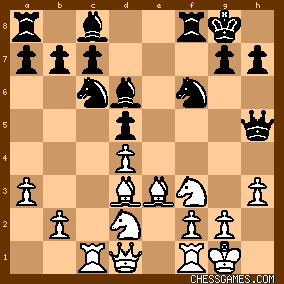
click for larger view15. Ng5
There was no reason to invite the trade of Queens. Popiel should have concentrated on building his position. Thus, 15. Re1 or 15. Be2 were better. 15... h3
Schlechter should probably have initiated the Queen trade here. But Popiel solves that problem for him. 16. QxQ
16. Be2 was better.
16... NxQ
17. Ngf3
From this point, and slowly but surely, Popiel allows his game to deteriorate. 17. Bh7+ followed by 17. Bg6 was better here. 17... Nf4!
Their are flashes of the real Schlechter in this game. 18. Bb5 Ne7
19. Rfd1
He might as well have played 19. BxN here.
19... c6
The main alternative was 19...Neg6
20. Bf1 Neg6
21. Rc3
The beginning of a wrong plan. 21. Re was better. 21... Bd7
22. Kh1
Popiel seems to have been playing in a haze here. 22. h4 or 22. Re1 were better. 22... Rae8
This left:
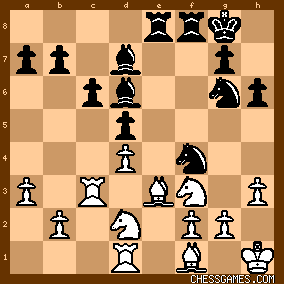
click for larger view23. Ng1
Another weak move by Popiel. 23. b4 to anticipate a possible a5 by Black seems best. The text does nothing to advance Popiel's game. 23... Ne7!
Preparing for Nf5 and a King-side attack. At this point, Schlechter appeared to be assuming a serious initiative. 24. g3 Ne6
25. Ndf3 Nf5
26. Kg2 g5
Schlechter was on the march at this point. Would he roll over the faltering Popiel? 27. b4
The position was now:
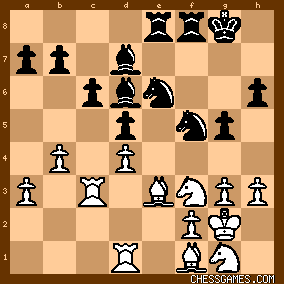
click for larger viewAny advantage Popiel had enjoyed was gone and Schlechter seemed on the verge of a decisive break-through. But from here though move 31, as I will discuss in my next post on this game, Schlechter lost the thread of the game and let Popiel fight his way back to equality. |
|
Aug-25-18
 | | KEG: Post III
27... Neg7
A needless retreat.
28. Bc1!
Correctly keeping his dark-square Bishop.
28... Ne6
29. g4
Nice to see some sign of life from Popiel. But the text creates to many weak squares around his King. 29. Rc2 was better. 29... Ne7
30. Bd3 Ng6
Schlechter should not have set this Knight up for capture. 30...Be8 or 30...Ref6 were better. 31. BxN! RxB
The dust has settled and now it is Schlechter who has lost the edge: 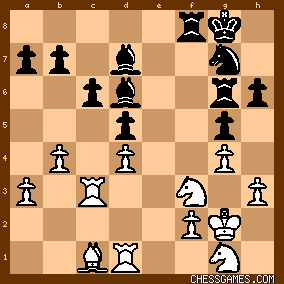
click for larger viewWith the forking 32. Ne5, Popiel would have forced the trade of Schlechter's Black-square Bishop and had at least equal chances. But from here on, his play collapsed. 32. Ne2?
Giving Schlechter a chance to exploit the weak squares on Popiel's King-side. 32... h5
The Tournament Book gave this move a "!", and I agree. 33. Nxg5?
After this lemon, Schlechter held all the cards. Popiel should have played 33. Ne5 or 33. gxh5 33... hxg4
The position was now:

click for larger view34. h4?
Popiel's only legitimate chance lay in 34. hxg4. The game should now be over. 34... Nf5
The game appeared to be over at this stage.
35. Rh1 Rgf6
36. f4 Re8
This should win, but 36...Rh6 was much stronger. 37. Kf2
Popiel remains in a daze. 37. Ng3 was his best chance. 37... Rh6
38. h5 Kg7
39. Rd3 Reh8
This is plenty good, but 39...Kf6 was more accurate. 40. Rg1
This left:

click for larger viewOne might assume that Schlechter would finish off Popiel in short order here. But Schlechter seemingly had a bad day at the office, and--as I will discuss in my next post on this game--nearly let Popiel off the hook before Popiel finally collapsed beginning with move 43. |
|
Aug-25-18
 | | KEG: Post IV
In the diagrammed position with which I ended my last post, Schlechter could have nabbed a pawn and won simply with 40...Rxh5 41. Rxg4 Nxd4 (since the White Rook on g4 would now be hanging). Even more devastating would have been 40...Nh4! follows by Rf6. But Schlechter still seemed to be asleep at the switch and instead played: 40... Ne7?
Now Popiel could have been very much back in the game with the not too hard to find 41. Nf3! (and if then 41...Rxh5 42. Ne5 with all sorts of counterplay). But Popiel erred with: 41. Ng3? Rf8
This is probably now sufficient for victory, but 41...Kf6 was better. 42. Re1 Ng8?
Another one of Schlechter's moves in this game that I find hard to fathom. 42...Nf5 was obviously better. The position was now:

click for larger viewPopiel is probably still lost, but he could have made matters very interesting by sacrificing the exchange here with 43. Re5?! But, yet again, his response was poor: 43. f5?
This left:

click for larger viewTo this point in this game, Schlechter had played like a lox. Furthermore, he had yet to win a game in the Munich 1900 tournament and his standing at 1-1 was not especially impressive. But from the above position the Schlechter many of treasure awoke, blew Popiel off the board, and ran off six wins in a row: 43... Ne7!
44. Kg2?
44. Nf3 or 44. f6+ were better, but the outcome would doubtless have been the same. 44... Nxf5
Picking up the pawn Popiel had hung two moves earlier. 45. N5e4
The Tournament Book assigns a ? to this move. 45. NxN+ certainly looks better, but it is hard to imagine that Popiel could have hed his wretched position after 45...BxN and 46. Rxh5. 45... Nh4+!
46. Kh1 Re6
With both Knights hanging, Popiel could safely have resigned here: 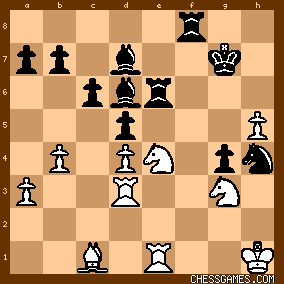
click for larger view47. Rde3 dxN
48. Nxe4 Nf5
Schlechter could have played the even more brutal 48...Bf4, but the game is clearly over. 49. Bb2?
Allowing a pretty finish by Schlechter, but by this stage it makes little difference. Perhaps he thought Schlechter would give him a chance with 49...NxR? 50. d5+ Ref6 51. RxN cxd5 52. h6+ Kxh6 43. NxR (leaving White "only" two pawns down). But Schlechter--now playing like Schlechter--played a much better move: 49... RxN
This left:

click for larger view50. RxR allows 50...Ng3+ with a winning fork. So... 0-1 |
|
|
|
|





































